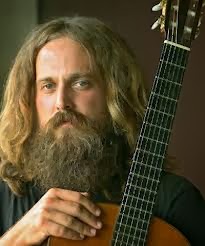IRON AND WINE AND THE DREAMS OF SAMUEL BEAM
an appreciation of seeing Beam and the gang live
By Sarah Zehr
 |
| A painting of Samuel Beam |
Samuel Beam, the musical mastermind behind his sometimes band Iron and Wine, was born July 26, 1974 in South Carolina. He released his first album Creek Drank the Cradle on the Sub Pop label in 2002. Beam often records his albums alone, but will go on tour with a full band, Iron and Wine. There is some confusion about the difference between Beam’s solo work and his Iron and Wine work and that’s because there’s no clear distinction, or at least any that he or the music is going to make clear. So, band or no band Beam is Iron and Wine, even though sometimes Iron and Wine is more than Beam, at least numerically. His music is simple and direct and critics have compared him to Nick Drake, Neil Young, Fleet Foxes and Simon and Garfunkel among other folk-pop luminaries. The comparisons are apt, but when I saw Iron and Wine live for the first time in a stunning show at the Fox Theater in Oakland I got the full scope of Beam’s music and ambitions. What at first appears to be direct and easily taken in is actually allusive, complex and rousing.
Entering the Fox Theater with the usual ooh’s and ah’s of its pre-war art deco beauty I made my way up to the general seating section where I could be closest to the band. Suddenly, I found myself surrounded by couples engaged in what one could only call advanced displays of public affection. They appeared to be trying to out love one another, like some Olympics of public groaning and groping. At first I was annoyed, but then I said to myself, “Come on Sarah, is this really surprising considering the dreamy romantic nature of the music”? So I didn’t call the vice squad and let the PDA festival slide.
 |
| Samuel Beam in the woods |
Beam’s music has a definite heaviness to it and he does not belong to any organized religion but is an agnostic when it comes to God. Raised Christian, Beam uses God as a symbol of many aspects of the world, but not as a belief system. It is this tension between the spiritual and the secular that charges a great deal of the music. Nature and family life are the touchstones of Beam’s music, although his use of both can be original and unsettling for dreamy, folk pop. While singing of a mother’s refusal to breast feed, Beam stops and jokingly reminds us that it’s just a song and that he and his mother are “cool with each other.”
After an obscenely long wait amongst the PDA crowd, the lights dim and Beam comes out. The crowd, hungry for entertainment, screams their approval and excitement. Beam has a big, grizzly man, I-haven’t-shaved-in-three-years beard, but seems both humble and approachable. He introduces himself, “Hi I’m Samuel Beam,” and then the rest of the band comes out. The band consists of, and this is amazing, a three-person string section, a two-person rhythm section, a-three piece brass band and three lovely backup singers. Suddenly, the music exploded out and you just had to dance—it was an explosion of joyousness, led by a friendly mountain man with an angelic voice.
 |
| An angelic voice and he's cool with his mother, that Samuel Bean |
For a folk singer, Beam sure has a whole lot of jazz and soul in him. I like it when musicians stray into genres that they aren’t known for and Beam was certainly not shy in giving his songs unexpected twists and turns. His lithe, angel voice gained forced amidst the gospel-tinged harmonies of his back up singers. Although Beam has a deep, masculine voice, it often slips into more feminine tones and ranges in his solo work. The full band seemed to release his he-man vocal chords and he let them loose amidst the funky keyboards, the jazzy brass section and the subtle but full sound of the strings.
It was a magnificent blend of edge and sensitivity. Between songs Beam bantered back and forth with the audience, having a conversation with a guy and his girlfriend who were standing right next to me, one of the lesser offending couples in the PDA Olympics. I like banter during live shows. For some, it might seem like insincere patter, but it always gives me a sense of the artist. Beam has an easy way about him that gives you the time and the space to take in the full scope of his music. You couldn’t have asked for a better live experience: the songs were familiar, but veered off into fascinating directions.
 |
| Fascinating re-mixes from Samuel Bean |
In the song “Your Fake Name is Good Enough For Me” Beam lists a string of things that “we will become.” When he gets to the line about “becoming a disco ball,” the lights mimic that well-worn nightclub effect and the band switches to a quick disco tune and then back again. It was so well executed that if you didn’t know the song well you probably wouldn’t have noticed it. Radical changes to songs in live performances are not always well received or welcomed, but Iron and White is so tight and adept at burrowing into each song that each change feels like a revelation.
Mid-way through the show Beam excused the band and played songs from his first few solo albums. They included, “Jezebel,” “Cinder and Smoke,” and a cover of The Postal Service’s song “Such Great Heights.” This part of the set had a nostalgic, familiar, folk quality to it. Beam asked for songs requests and as surely as the sun rises someone yelled, “Free Bird”! And so Beam quiets everyone down and strums the unmistakable Lynyrd Skynyrd introduction to one of the most over played songs ever written. The PDA couples swayed and whooped and then he stopped, chuckled and said, “Just kidding! I am not going to play that…that was a joke.” The vibe was so loose and congenial that everyone laughed and Beam went straight into his next song, “Grace for Saints and Ramblers.”
 |
| What's behind the curtain, Samuel Bean |
At that moment I felt as if I had been to two different concerts: one, jumpy, upbeat and unpredictable and everything that you would expect from a talented and idiosyncratic large band; the other show was quiet, contemplative and intimate. In his folkie, contemplative guise, Beam didn’t stray far away from what the songs sound like on the albums and yet watching him perform somehow changed the songs. If possible, the songs became even more sincere and emotional.
While covering a Calexico song, “Sixteen-Maybe Less” I actually paid attention to a lyric I hadn’t noticed before, even though I’ve heard the song many times. It was, “I met my wife at a party, when I drank too much.” In the performance, he almost just said it rather than sung it and that made me listen in a different way. The concert went on like this for about thirty minutes. Beam stood under the loan spotlight and basically made us all fall madly in love with his sweet sad music over and over again by making us pay attention. Then, just as he held us in full folkie hypnosis, he asked his band to come back and play the last few songs with him.
 |
| Samuel Bean, in the woods again: Grizzly Man meets Grizzly Bear |
You might think that when the band regrouped on stage that they would blow the audience, stoned from the calm of Beam’s solo work, away. You would be wrong. As energetic as they were in the first half, they stayed controlled and quiet, as Beam’s voice floated above their dimmed sound. They finished the night with profuse and sincere thanks to us for being such a great audience and broke into “Baby Center Stage.” The band played slowly and Beam sang with painful precision, articulating every word carefully and melodically—the man knows how to make you listen. The audience swooned, even the uncoupled among us, and relaxed while enjoying the final moments of the powerful presence of Beam and his Iron and Wine.
 |
| Samuel Beam reflected |
©The CCA Arts Review and Sarah Zehr

No comments:
Post a Comment